Long tests: Interlux Pacifica Plus and Torqeedo Travel 1003
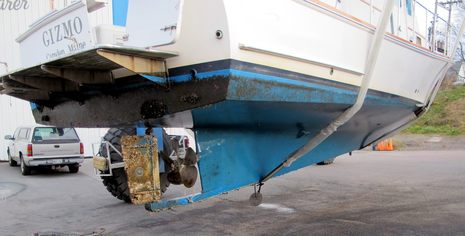 That’s a darn impressive photo, I think. When Gizmo was hauled on November 22, she hadn’t been out of the water since May 2012, and most of that copper-free Interlux Pacifica Plus bottom paint had already endured a seven-month test in 2011, as I wrote about then. So, after more than three seasons, most of the running surfaces are still slick (and probably still self-cleaning when the boat occasionally goes fast). I did use the remains of the original two gallons to repaint the belly band before the 2012 launch; Gizmo lay in cleansing South Carolina fresh water from November that year through March of this year, and I scrubbed the belly band from the tender last July. But notice how almost no barnacles or mussels — the critters that can really slow a boat down — adhered to the Pacifica Plus…
That’s a darn impressive photo, I think. When Gizmo was hauled on November 22, she hadn’t been out of the water since May 2012, and most of that copper-free Interlux Pacifica Plus bottom paint had already endured a seven-month test in 2011, as I wrote about then. So, after more than three seasons, most of the running surfaces are still slick (and probably still self-cleaning when the boat occasionally goes fast). I did use the remains of the original two gallons to repaint the belly band before the 2012 launch; Gizmo lay in cleansing South Carolina fresh water from November that year through March of this year, and I scrubbed the belly band from the tender last July. But notice how almost no barnacles or mussels — the critters that can really slow a boat down — adhered to the Pacifica Plus…
Gizmo’s port side, which gets more sun at her Camden home float, did have more slimy weed on it, but I don’t think it hurts the boat’s performance much. I don’t like how the slime looks, but I could have scrubbed it off easily as the ablative paint was still very soft. That’s a finger swipe near the aft waterline in the photo below, and you can see how the pressure hose is sending blue paint into Wayfarer Marine’s catch basin (it’s a certified “Clean Marina”). Of course, if I’d done more scrubbing, I might have stripped off all the active paint — a rationale for sloth? — but overall it seems like I got a whole lot of value from two gallons of Pacifica Plus that cost about $400. It also seemed good not to ablate cuprous oxide into the water (and boatyard workers), though I realize that the jury is still out on the environmental and health effects of the paint’s Biolux and Econea biocides.
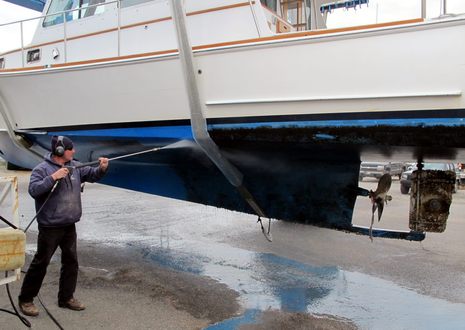 I would like better protection against our aggressive local slime, though, and may get to test Pettit Hydrocoat Eco next. It’s copper-free and water-based, uses the same apparently effective Econea to discourage critter settlement, but contains what may be a different zinc-based, slime-blocking biocide (the product and safety sheets for these paints are informative but also confusing to someone who is not a chemist). I’m pretty sure that Hydrocoat Eco — which I learned about when we gave it an IBEX Innovation Award — is the same as the West Marine CFA Eco that was honored as a… um… West Marine Green Product of 2013.
I would like better protection against our aggressive local slime, though, and may get to test Pettit Hydrocoat Eco next. It’s copper-free and water-based, uses the same apparently effective Econea to discourage critter settlement, but contains what may be a different zinc-based, slime-blocking biocide (the product and safety sheets for these paints are informative but also confusing to someone who is not a chemist). I’m pretty sure that Hydrocoat Eco — which I learned about when we gave it an IBEX Innovation Award — is the same as the West Marine CFA Eco that was honored as a… um… West Marine Green Product of 2013.
I’d be happy to see if ECO is as effective as claimed (the safe, green aspects are hard to quantify) and the Gizmo plan is to stay in the water from at least May 2014 until late 2015. But, let’s all note that an anti-fouling paint works differently in different environmental conditions and on different boats. For instance, I saw a Practical Sailor comparison in which Pacifica Plus didn’t do well, but then it occurred to me that their fixed panel testing misses the ability of some paints to easily slough off growth while underway at a speed. Or am I missing something?
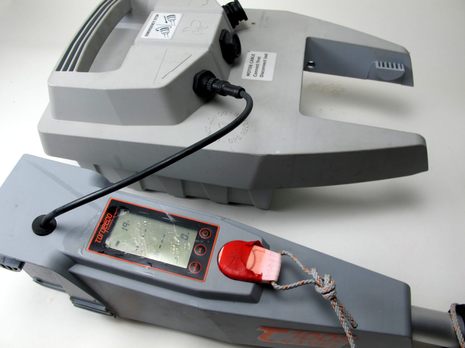 The long test of the Torqeedo Travel 1003 electric outboard also started in May 2011 and has gone equally as well in my view, though the story is more complicated. I declared my love for the Torqeedo soon after I got it, but if you read through the 80 comments to that thread, you’ll learn that some owners were frustrated by various issues. While my test motor ran fine, fairly early on I realized that if I cranked it to top speed, I’d hear a nasty lower unit whine and sometimes experience a protective shut-down with the E45 (“battery overcurrent”) error message showing on the display. However, it always restarted very easily — turn off, then turn on — and I rarely use the motor at max speed anyway.
The long test of the Torqeedo Travel 1003 electric outboard also started in May 2011 and has gone equally as well in my view, though the story is more complicated. I declared my love for the Torqeedo soon after I got it, but if you read through the 80 comments to that thread, you’ll learn that some owners were frustrated by various issues. While my test motor ran fine, fairly early on I realized that if I cranked it to top speed, I’d hear a nasty lower unit whine and sometimes experience a protective shut-down with the E45 (“battery overcurrent”) error message showing on the display. However, it always restarted very easily — turn off, then turn on — and I rarely use the motor at max speed anyway.
But this spring — when I was using the 1003 on the little tender down south — the “noise” seemed to be getting worse and I’d also managed to drop the battery onto the tiller handle, which tore the clear plastic over the LCD display (see photo above). So after getting home, I sent it in for servicing, which is when I learned that early production units (like mine) had a problem with badly fastened magnets in the “motor bell.” The loose magnets were causing the noise and also straining the motor enough to cause the protective E45 shut down. Torqeedo had fixed the problem in design and assembly a long time ago, and Torqeedo USA fixes it for free even when the motor is past the two year warranty – so all good.
Torqeedo also replaced the display cover and sent the repaired components back to me where the 1003 ran like a top, even at high speed, for about one day! That’s when I experienced true Torqeedo frustration. Sometimes the motor ran fine, but other times it would give me E45 or E21 (“tiller calibration defective”) errors and refuse to start no matter what I did. I figured out what was going on when I turned the tiller over and saw water collecting inside the display cover. I couldn’t really blame Torqeedo as it was me who used the broken tiller for a month, some of it quite wet, and obviously the water that got itself inside the sealed display box didn’t cause an issue until after the darn tiller came back to Maine. Plus once the new tiller arrived, the motor ran flawlessly until I put the big tender away last month.
Now here’s the really good news… During all this I learned that Torqeedo parts and estimated labor are quite reasonable. A whole new tiller is $199 and the Motor Bell would have cost $86 and an hour labor (rate depends on which Torqeedo service location you use). The prop is $80 and the skeg is $30. I’ve been advised to have the main seal checked because I’ve left the motor in the water for three seasons (see photo below), but that’s estimated at 1 hour labor plus a new $22 gearbox cover. And even if I manage to ruin the submerged electric motor, a replacement “pylon” (see parts book) only cost $749, which seems about right given the whole motor’s $2,000 retail price. These numbers look especially good to a guy who’s used to engine parts that seem vastly inflated (I’m looking at you, Volvo Penta).
Besides the relatively high price, possible Torqeedo owners may be put off by the idea of an unusual outboard that uses parts imported from Germany, but now I don’t think that’s a real worry. In fact, I’m still in Torqeedo love and hopefully not nearly done testing this Travel 1003.


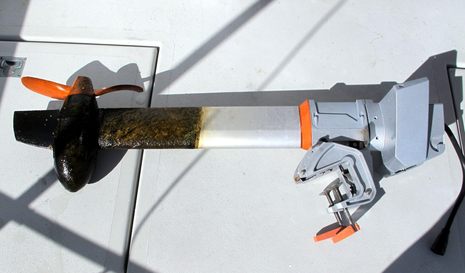
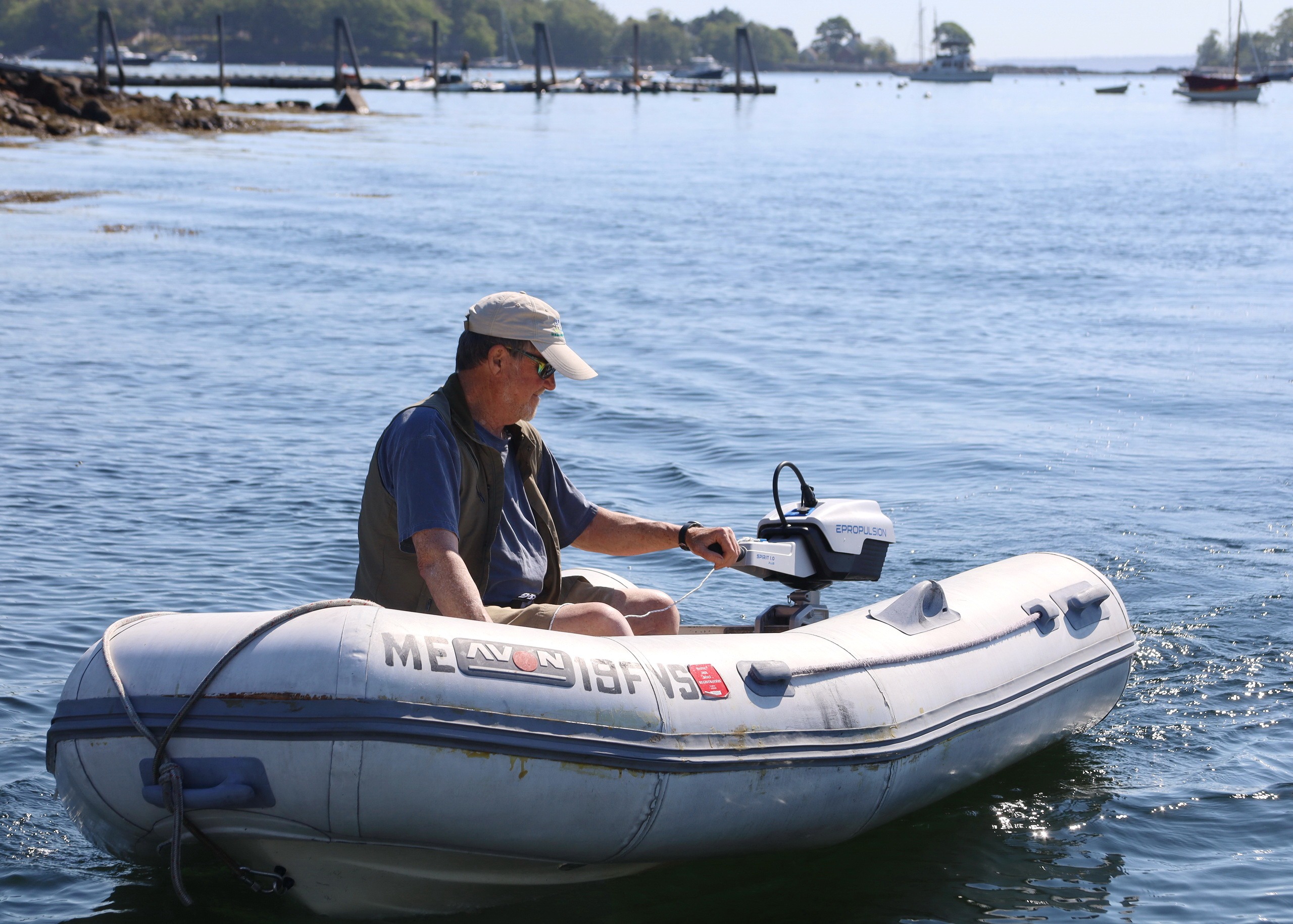

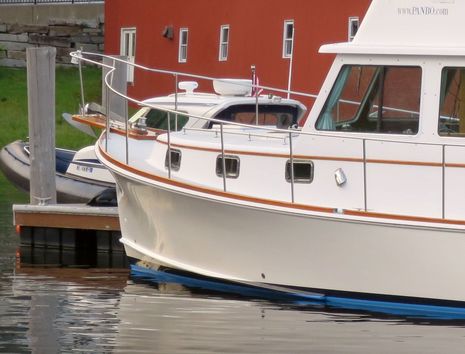
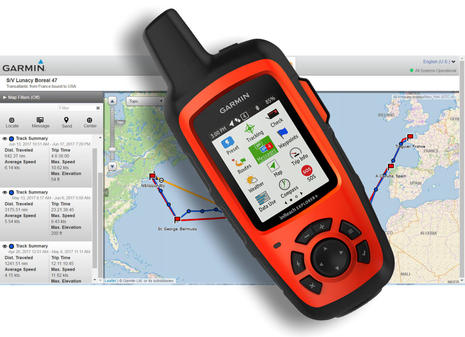







PS Torqeedo’s magnetic “ignition key” doesn’t stand up to a lot of sun, as seen in the next to last photo, but I learned that any strong magnet works.
PPS If you click on the top photo to make it big, you will see what a poor idea it was to use ablative anti-fouling paint on a stainless rudder that’s regularly in the wash of a 28×28 five-bladed prop driven by a 450hp engine. I probably should have used the same Pettit Zinc Barnacle Barrier that did pretty well over 18 months on the prop itself:
http://www.pettitpaint.com/product.asp?id=262
but I’m interested in alternatives for both…
Also, no blame to the Interlux Pacifica Plus for all those barnacles under the keel. I know the exact location of the bump in the southern New Jersey Intracoastal Waterway where I left that paint 😉
We’ve learned to live with our Travel 1003.
Essentially, treat the throttle as if it is a nuclear bomb: very gingerly. You can engage it, but slowly. You can floor it, but very progressively. You can reverse it, but gradually. Anything else, and be ready to face the E-demons: the thing locks up and must be rebooted.
I’ve looked into getting a Li-Ion or similar small/lightweight 12V batt to provide up to 50 watts of power/recharge _during_ use of the 1003, like some Aussies do, but at circa $350 when it is all said and done, am rather considering just biting the bullet and getting a second Torqeedo-brand battery for $700.
In addition to the Travel 1003, we have a brand new Tohatsu in the lazarette since almost a year ago. We’ve never used it yet. Ethanol, oil, weight, refueling, who has time for that? Eventually we’ll need its power or range, and that’s why it’s there, but I dread the day.
So the electric is just an easier package, but it is heavy on the wallet and requires deliberation when in use.
Where did you moor in fresh water in South Carolina?
Ben,
What paint did you use on the rudder? With the bottom looking so good the rudder has a lot of growth. I wonder if the rudder sees more turbulence and allows the ablative paint to bleed off more quickly then the paint on the bottom.
The prop on Gizmo looks fine. I used the same Pettit #1792 from a spray can and experienced the same performance, which is very acceptable in my opinion. I think the only alternative worth a try, at great cost, is PropSpeed, http://www.propspeedusa.com. Some people in the boat yard love it and some did not have success with it. I’m told the application of PropSpeed is very tricky and may be the reason for some failures.
Orin, my boat spend last winter (Nov. thru March) at Osprey Marina near Myrtle Beach, SC. If you look on the Transient page here, you’ll see that they describe themselves a freshwater marina and the location is a man-made basin near the upper reaches of the Waccamaw River (which is used as the ICW):
http://www.ospreymarina.com/
It’s a bit mysterious as there are tides at the marina, and I didn’t taste test or swim in the water (it’s very brown) but I did observe the fairly rapid death and disappearance of waterline weed that looked something like the photos at top when I arrived.
Then a new kind of slime grew on the boat (which also got covered with incredibly sticky yellow pine pollen). The freshwater fouling died when I got in salty water again; in fact, the bottom paint looked really good by the time I got back to Camden in early May. (But I still sometimes find clots of the pollen stuck to things.)
All in all, the salinity change was a neat bonus on top of what is already a well managed, super safe, and reasonably priced marina. It may also account for the fact that all my Zincs survived the 18 months, though some were close. Incidentally, the heavy mussel growth seen on the underwater lights and aft zinc must have happened this fall; otherwise I would have stiff brushed it off.
Richard, I tried Pacifica Plus on the rudder in May 2012 because I didn’t have enough zinc spray. I think it’s fine to use on any metal (because it contains no metal) but it obviously couldn’t handle the prop wash.
We had horrible success with Pacifica on a sailboat in MD. In fact, oysters grew all over it like it was a most wonderful host. The paint came from Interlux as a gift because the previous coating of Micron 66 had “cornflaked” in low salinity water of that weather freaky year, 2010 ?, where a lot of rain had fallen on NY and VT and then watershed’d its way down and into the Chesapeake. I wondered if the paint gifted had been from a previous formula because on another boat and one painted more recently, the results are better. With the oyster’d boat, we were told that the boat “needed more use”. That’s a great command but sometimes not practical. Never-mind, the failure prompted a move to Petitt and to their heaviest copper offering, a paint that PS recommends. The proof is that it was clean/clean at this week’s haulout. This same customer bought a Torqueedo at the Boat Show year before last and loves it so much .. it’s kept under lock, key and glass cover. I’ve used it once, and have to row out to the mooring !
I’d love to see a long term test of an ultrasonic anti-fouling system like this one:
http://www.westcoastultrasonics.com . I’ve been pondering this option every time I haulout my boat and have to paint.
Adam, my friend Charlie Doane has been testing ultrasonic anti-fouling on his aluminum sloop Lunacy for about three years. I think this is latest post on Wavetrain:
http://www.wavetrain.net/the-lunacy-report/411-ultrasonic-antifouling-second-full-season-results
Charlie has also tried several copper-free paints (none of which made him happy) during this same period. Plus he’s using the single frequency UltraSonic brand while you referenced the Soanar brand which works at multiple frequencies.
Also, PYI has just started distributing the Sonihull multi-frequency anti-fouling system:
http://www.pyiinc.com/sonihull/sonihullduo.html
Neat that eMarine has a small solar panel for charging Torqeedo batteries and also a 12v charging cord, both reasonably priced, I think: http://goo.gl/ktA78l
Looks like a reasonable item, surely a desirable thing. I will say that $26 is a bit steep for the 2.5 mm plug. When I wired one to the 12 v panel on my boat, I think a pair of the 2.5 plugs cost about $3. That’s retail, in a radio shack in Maine. Sure, the cable is one piece and more water resistant, but really, I don’t think that I’d consider leaving the battery unit exposed to water when charging. Ever. The panels are quite nice.
Ben: I’ve been using a Torqeedo Travel 1003 since 2013 on my 27 foot sloop (2400 lbs.). Very easily driven hull, and I can get about 6 miles if I go easy on the throttle. I only use the motor when it’s flat calm, otherwise I sail. Thus I had to have a 2nd battery to have some reserve when cruising, and I had to find a place to plug in overnight once in a while.
Two years ago I decided to go solar, but the Torqeedo solar panel was very expensive and much too big for my boat. You need 50 watts to charge their 24 volt battery directly. But then I saw that you could get a cable from them to charge from a 12 volt marine battery. And I could get a 40 watt solar panel, that was small enough for my aft deck and much cheaper, and would charge the 12V battery. Now I keep one Torqeedo battery plugged into the 12V battery in the laz, which is being trickle charged constantly by the solar panel. When the motor battery gets low I swap them, and since the 12V battery is constantly full it will charge the spare battery to about 80% in just a couple of hours. This allows me to motor for most of a day if I should need it.
It all fits in my small lazarette, and worked flawlessly for my 6-month season last summer.
Thanks, Andy, this is good info that may be useful to some Torqeedo outboard owners, including me.
But aren’t you also the guy who learned that a 1003 is buoyant enough that if you drop one off the stern in a bit of a tidal current, it may wander off to parts unknown? 😉
Andy replied via email:
***************************************
Yup. It sank, but then wandered off. It’ll probably turn up in Camden.
But that was only half of it. After replacing it (with a used one), last spring when Bob V. launched her he turned too sharp pulling her out of the TravelLift and broke that one off. He had a diver fetch it the next morning and when they opened it up (a week later) there was salt water and corrosion inside.
Now that was an older motor, but I had just (a month earlier) had it factory serviced and re-sealed, and they saw no evidence of any corrosion then. So Bob had to buy me a new pylon. He was pretty grumpy about it, but he did it.
Moral of that story…when they say it’s waterproof to IP67 (1 meter for 30 min.), they mean it. (And I do have a leash on it finally…and it’s less than one meter long.)
I have several reservations about these motors, but I’ve got it, and it means I don’t have any oil or gas on board, very little noise, I can lift it with one hand, and it runs reliably. I think my first battery (2013) will probably give out in a year or two, so that means it costs me about $100/year, although the motor was expensive.
My reservations they claim are getting fixed in a new model coming soon. The Tilt-Lock mechanism breaks in less than one season. The plastic threads on both the tiller connection and the power connection cross-thread and strip very easily, and the lock-down lever (for reverse) requires you to be an acrobat if you’re not in a dinghy.
The US big guy for the company did respond to my complaints on these items and claims they are working on it.
The new Travel 1103 C is out with some of those improvements plus more power and even less noise:
https://www.torqeedo.com/us/en-us/products/outboards/travel/travel-1103-c/M-1151-00.html
I’ll get to try this and lots of other Torqeedo gear in Germany early next month, and will report back.
Tiller handle Torqeedo 1003 shutting motor down sending error message 23. I solved this problem by taking tiller handle apart drying out electrical circuit board and spraying w40 on the 3 contacts buttons. setup,cal, and start. Rust had formed on buttons after water had gotten in through clear plastic multifunctional display.